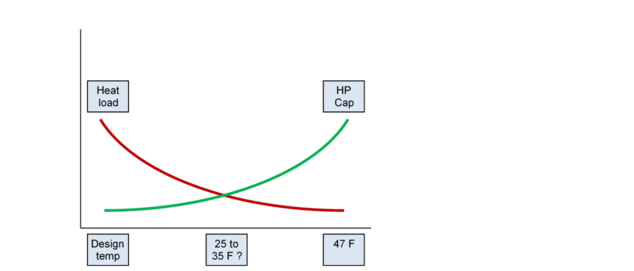For actual applications, ASHP sizing and selection is a combined function of design cooling Loads and heating balance point. The cooling loads are usually the priority in a climate with significant cooling load, especially if it is a humid climate. On the other hand, the preferred heating balance point (the lowest outdoor temperature at which the ASHP meets the entire heating load) is typically in the 22 to 32 °F range. If driven purely by cooling requirements, both heating and cooling capacity would be sized at about 100 to 110% of the cooling load. This approach is meant to provide efficient cooling operation and effective dehumidification. In climates with mild winters, this may provide ample capacity to meet all heating loads. In colder climates, however, this approach to sizing will tend to address some significant fraction of the heating load, but not all of it. The rest will be addressed by a backup heat source. To minimize dependence on the backup heat source, a somewhat larger unit may be selected in order to provide a lower heating balance point with respect to outdoor temperature. However, where the climate is not all that cold, oversizing with respect to heating to achieve a low balance point temperature may reduce seasonal heating efficiency if it leads to a majority of operating hours at low part-load fractions, which is significantly less efficient than operating the heat pump at or near full load. Furthermore, part-load operation at low outdoor temperatures is doubly inefficient: at an outdoor temperature of 37°F, the COP for a typical heat pump can drop below 1.0 if the load is less than about 30%. Finally, if dehumidification is anticipated when in cooling mode (i.e., in all but notably dry climates), best practice, even when seeking a lower heating balance point, is to avoid sizing the unit greater than 125% of the cooling load. Getting this right requires a somewhat sophisticate bit of logic.

Maybe best to simply size ASHP capacity at 47°F OA source temp to equal required heating capacity at design heating condition. Until we build some or all of this logic into the software, user intervention will be required to determine appropriate sizing of the ASHP component in ApacheHVAC. As of VE 6.4, the ASHP capacity at 47°F outdoor temperature will, for systems 2 & 4 when used in an ASHRAE 90.1 PRM Baseline model or when requested by the user, be set equal to the DX cooling capacity. However, in the rare case of spaces with both moderate cooling loads and substantial heating loads occurring when outdoor temperatures are above 40°F, it will be incumbent upon the user to check that these heating loads are not exceeding the ASHP capacity and causing use of backup heat when outdoor temperatures are greater than 40°F. The reason for this is that the backup heating for ASHPs in ApacheHVAC does not include an arbitrary high limit input for the backup heat source. Rather, the backup supplements the ASHP when the latter cannot fully meet the load.
A further refinement will extend this logic as follows, using an additional special-purpose heating design sizing run with the outdoor temperature forced to 40°F.
For true PRM Baseline systems (i.e., only when such system are used in PRM Baseline models), in order to have the electric resistance heat share the load at a temperature closer to the 40°F outdoor maximum for back operation, the ASHP heating capacity should be the greater of the following:
1) the associated cooling capacity
2) heating capacity sufficient to maintain the space heating setpoint without solar or internal gains when the outdoor temperature is 40°F
When the heating capacity must greater than the desired cooling capacity such that the backup source will never be required when the outdoor temperature is above 40°F (#2 above), the associated DX cooling capacity will need to be increased to match the heating capacity. This scales the performance curves in the DX cooling dialog so that the part-load efficiencies are correct.
The ASHRAE PRM specification includes the very clear statement regarding controls to prevent backup electric heat operation above outdoor temperatures of 40°F; however, this applies only to software that is incapable of modeling a true back heat source that is used only when the primary (ASHP) heat source is unable to meet the load as a function of outdoor conditions and/or indoor heating loads.
The PRM is also unclear with respect to the actual sizing of heat pump equipment for baseline systems. If, for example, ASHP is required by ASHRAE to be 25% oversized beyond that required just to meet the space conditioning load at the design condition